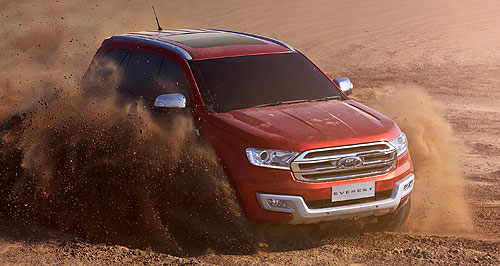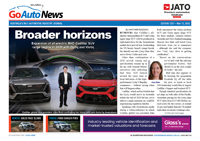Make / Model Search
Future models - Ford - EverestBangkok show: Ford Everest debutsReady to rock: Built in Thailand but bred in Australia, the Everest made its ASEAN debut in Bangkok this week, shown here for the first time in right-hand drive. Ford’s Everest SUV promises unprecedented on-road refinement/off-road abilityGallery Click to see larger images 26 Mar 2015 FORD Motor Company presented the right-hand-drive production-ready version of the Australian-developed Everest SUV at the Bangkok International Motor Show this week, providing key details such as final engine outputs and a broad specification outline ahead of its launch here in September. Making its ASEAN debut after the production model surfaced in China late last year, the seven-seat wagon – which is based on the Ranger utility – gains the latest Sync2 voice-control system that debuted in the FG X Falcon sedan late last year. As with the headline options announced for the updated PX Series II Ranger XLT that was also shown in Bangkok, and due for release in Australia in late July, the Victorian designed and engineered SUV will be well-equipped at launch, offering various active safety technology including 'adaptive cruise control' and 'lane keeping assist'. The Everest will also be available with 'active park assist', 'curve control' (which works with roll stability control and electronic stability control during cornering) and blind-spot monitoring with 'cross-traffic alert'. This confirms GoAuto’s exclusive report and photographs of prototypes last year, that revealed high levels of anti-crash technology being engineered into the Thai-built SUV. Other innovations include the option of an electrically operated folding third-row seat, a powered tailgate release and ‘active noise cancelation’ technology. Ford also claims the SUV has an abundance of cabin sealing and sound absorbing material to ensure class-leading refinement. To that end, the back windows’ outer edges feature ‘kickers’ designed to redirect airflow more efficiently and quietly. The drag coefficient rating is 0.389Cd, as tested and honed at the $20 million Advanced Centre for Automotive Research and Testing (ACART) at Ford’s You Yangs proving ground near Geelong. The Everest will offer two TDCi turbo-diesel powerplants at launch – a 118kW/385Nm 2.2-litre four-cylinder and 147kW/470Nm 3.2-litre five-cylinder related to the units found in the updated Ranger, although the larger engine receives updated exhaust gas recirculation for increased efficiency. Both drive either the rear or all four wheels via a six-speed automatic transmission. Unlike in other markets, the Ranger’s improved cable-operated six-speed manual alternative will be unavailable on the seven-seater wagon. Economy and emissions information are yet to be revealed. One area where Ranger and Everest diverge is with their rear suspension systems, due to a completely different rear floorpan. Out goes the truck’s leaf springs for coil springs and a Watt’s linkage configuration – hints of ’80s heyday-era XE/XF Falcon sedan there – for what Ford’s engineers insist will be “a comfortable, stable ride with agile and predictable handling on the road, keeping the promise of Ford’s fun-to-drive DNA”. Front suspension is by MacPherson struts, while the steering is a new electric power-assisted set-up in lieu of the current Ranger’s hydraulic set-up. For off-road performance, the Everest is available with Ford’s sophisticated ‘terrain management’ four-wheel-drive system. Offering four settings – Normal, Snow/Gravel/Grass, Sand and Rock – the system alters the throttle, transmission and traction control automatically. Manual transfer-case lockout in low-range 4WD mode is also part of the package. Ford claims the Everest has best-in-class attributes in a number of areas, including its 225mm ground clearance and 800mm water-wading capability. High-series models come with 20-inch alloy wheels. Targeting the Toyota Prado, Holden Colorado, Isuzu MU-X and Mitsubishi Challenger in Australia, the Everest employs a body-on-frame design “assuring the torsional strength required for challenging terrains.” To that end, the 4x4 versions also include an active transfer case with ‘torque on demand’, meaning drive is metered out to the front wheels only when required. Inside, the dashboard architecture is shared with the Ranger barring a few trim and material differences related to the SUV’s passenger-focused nature, with an eight-inch touchscreen dominating the centre console. Ford’s thinnest-ever rear seats attempt to maximise space due to compromises inherent in separate-chassis construction, while other highlights of the package include a dual-panel sunroof, 30-plus storage panels and multiple power outlets. Up to 2010 litres of cargo space is available, while payload is rated at 750kg. More Everest details will be revealed closer to the late third-quarter launch date.  Read more25th of March 2015  Next Ranger development set to stay in MelbourneFord Australia will continue to design and develop the Ranger beyond this generation24th of March 2015  Ford Ranger butches up with PX Series IIRanger’s Aussie designers had to balance Ford ‘tough truck’ mantra with quality feel27th of November 2014  Everest to be Ford’s flagship SUVFord’s marketing boss says Everest won’t compete with Holden Colorado 74th of November 2014  Ford to build Everest in ChinaChinese market to get locally built Ford Everest SUV with petrol engines12th of August 2014  Exclusive: Ford takes safe route with EverestAnti-crash technology in the engineering pipeline for Ford’s seven-seat Everest SUV1st of April 2014  Exclusive: Ford guns for Prado with 2015 EverestToyota SUVs seen at Ford proving ground as Everest pitched against SUV benchmarkAll future models Alfa Romeo Alfa Romeo Abarth Abarth Alpine Alpine Alpina Alpina Audi Audi Aston Martin Aston Martin BMW BMW Bentley Bentley Chery Chery Brabham Brabham Chrysler Chrysler Chevrolet Chevrolet Cupra Cupra Citroen Citroen DS DS Dodge Dodge Fiat Fiat Ferrari Ferrari Foton Foton Ford Ford Great Wall Great Wall FPV FPV Haval Haval GWM GWM Honda Honda Holden Holden Hummer Hummer HSV HSV Infiniti Infiniti Hyundai Hyundai Jaguar Jaguar Isuzu Isuzu Kia Kia Jeep Jeep Land Rover Land Rover Lamborghini Lamborghini Lexus Lexus LDV LDV Mahindra Mahindra Lotus Lotus Mazda Mazda Maserati Maserati Mercedes-AMG Mercedes-AMG McLaren McLaren MG MG Mercedes-Benz Mercedes-Benz Mitsubishi Mitsubishi Mini Mini Opel Opel Nissan Nissan Peugeot Peugeot Pagani Pagani Proton Proton Porsche Porsche Renault Renault Ram Ram Rover Rover Rolls-Royce Rolls-Royce Skoda Skoda Saab Saab SsangYong SsangYong Smart Smart Suzuki Suzuki Subaru Subaru Toyota Toyota Tesla Tesla Volvo VolvoEverest pricing
Motor industry news |
Click to shareFord modelsResearch Ford All future models Alfa Romeo Alfa Romeo Abarth Abarth Alpine Alpine Alpina Alpina Audi Audi Aston Martin Aston Martin BMW BMW Bentley Bentley Chery Chery Brabham Brabham Chrysler Chrysler Chevrolet Chevrolet Cupra Cupra Citroen Citroen DS DS Dodge Dodge Fiat Fiat Ferrari Ferrari Foton Foton Ford Ford Great Wall Great Wall FPV FPV Haval Haval GWM GWM Honda Honda Holden Holden Hummer Hummer HSV HSV Infiniti Infiniti Hyundai Hyundai Jaguar Jaguar Isuzu Isuzu Kia Kia Jeep Jeep Land Rover Land Rover Lamborghini Lamborghini Lexus Lexus LDV LDV Mahindra Mahindra Lotus Lotus Mazda Mazda Maserati Maserati Mercedes-AMG Mercedes-AMG McLaren McLaren MG MG Mercedes-Benz Mercedes-Benz Mitsubishi Mitsubishi Mini Mini Opel Opel Nissan Nissan Peugeot Peugeot Pagani Pagani Proton Proton Porsche Porsche Renault Renault Ram Ram Rover Rover Rolls-Royce Rolls-Royce Skoda Skoda Saab Saab SsangYong SsangYong Smart Smart Suzuki Suzuki Subaru Subaru Toyota Toyota Tesla Tesla Volvo VolvoEverest pricing
Motor industry news |
































Facebook Twitter Instagram